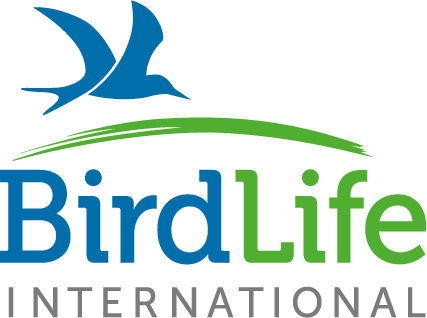1) Barup Sø
2) Bavnehøj Recreational Area
3) Bøtø Nor
4) Gedser Odde
5) Hyllekrog Saksfjed
6) Kalløgrå
7) Majbølle Nor
8) The Maribo lakes
9) Møns Klint
10) Nakskov Indrefjord
11) The Nyord meadows
12) Ålebæk Strand
Barup Sø
Falster, west of Stubbekøbing
One of north Falster’s best localities for birds in springtime
See Google map for parking site etc.
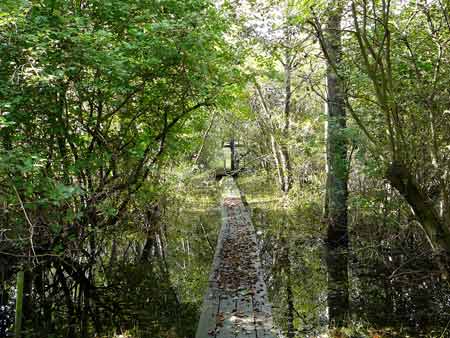
Boardwalk at Barup Sø. Photo: Joy Klein
Description:
Barup Sø is one of several lakes and bogs that were formed in a long sub-glacial trench valley stretching from Nørre Alslev to Stubbekøbing. 4-5000 years ago the valley was a narrow fjord. In the 1930s it was attempted to drain the lake and cultivate grass for hay on the reclaimed land, but the area could not be drained sufficiently and the project had to be abandoned. The lake returned, and immediately afterwards ducks and other waterfowl appeared and black-headed gulls established a colony. In time, however, the area became overgrown with reedbeds and willow scrub and the gull colony disappeared in 1960.
In 1988, the area was purchased and is now a reserve under the Bird Protection Foundation.
A large part of the reserve consists of reedbeds, whilst the lake itself is limited to small open stretches of water. However, in extremely wet periods the whole reserve can be transformed into a large lake. Willow scrub and alder copses form the remaining vegetation.
Birds:
Breeding birds:
The reserve houses many breeding birds that are typical for reedbeds. There are many breeding water rail, a pair of bittern and several pairs of marsh harrier, together with sedge warbler, marsh warbler, reed warbler, bearded tit and reed bunting. The uncommon Savi’s warbler has been heard on several occasions. Mute swan, mallard, moorhen and coot nest on the islets.
Many thrush nightingales breed in the willow scrub between the car park and the observation tower, making Barup Sø the best locality on Falster for this species. Other breeding birds are great spotted woodpecker, lesser spotted woodpecker (in some years), and all the birds usually found in boggy areas and scrub, including long-tailed tit, treecreeper and starling. Some years, pied flycatcher and red-backed shrike are seen. Buzzards breed in the alder copse.
Migrating and staging birds:
At the end of August, millions of gnats swarm over the reedbeds and attract many swallows on their way south. Flocks of starling stop off here before they continue migration. This is also the time of the year when osprey can be spotted.
Visiting and access:
From the E47 motorway, which crosses Falster, turn off at junction 43 and drive towards Stubbekøbing on route 293. In Blæsebjerg, turn right in the direction of Lillebrænde. After just under 1km a Bird Protection Foundation sign can be seen indicating where one can park at the side of the road. From here, a track crosses the fields and leads to Barup Sø. An information board has been erected at the entrance to the reserve. A boardwalk leads to an observation tower at the southern end of the reedbeds, but there is no entry to the tower for the time being. However, a good view of the reserve can be had by driving along Barup Søvej north of the reserve, where one can park at the side of the road.
Barup Sø is always worth a visit, but the period from early spring to mid-summer is definitely the best time.
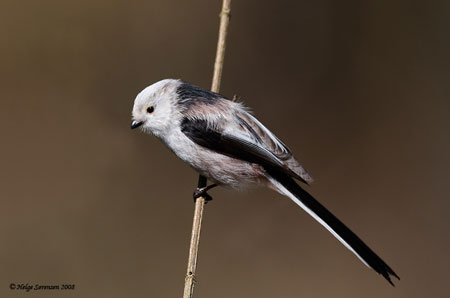
Long-tailed tit. Photo: Helge Sørensen
Bavnehøj Recreational Area
North Falster
A gravel pit with a varied birdlife, especially in the breeding season
See Google map with car-parks etc.
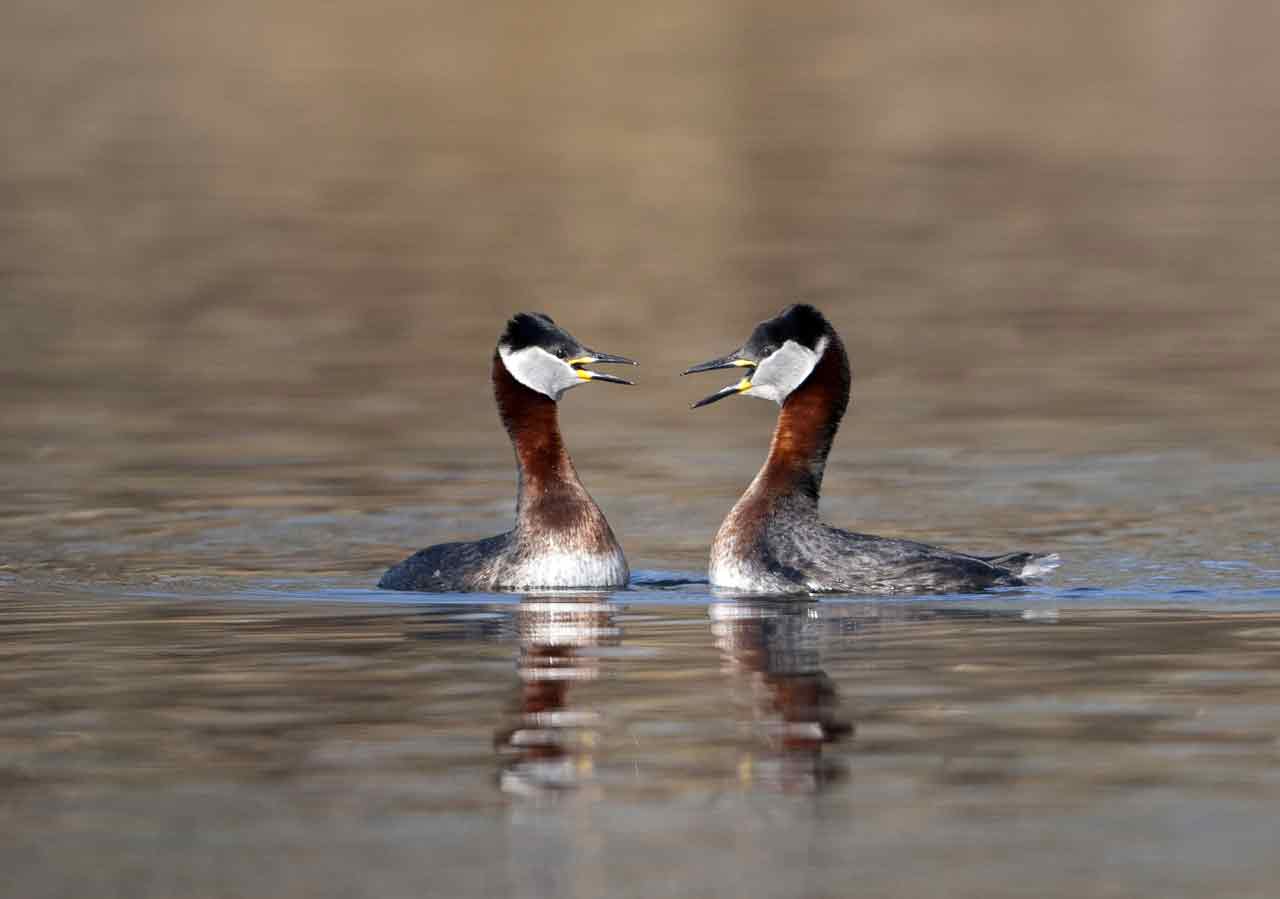
Red-necked grebes. Photo: Klaus Dichmann
Description:
Bavnehøj Recreational Area is a gravel pit situated in the north of the island of Falster. Work is still being carried on in the pit, but the municipality, in co-operation with the owners, has established a nature trail all the way round the pit, and from here there is a good view over the whole area. The trail is a combined trail for walkers, cyclists and horse-riders, and is also popular with joggers. Three covered observation shelters have been built along the trail. The trail does not seem to have any negative effect on the birdlife, although the dog training that goes on (usually in the evening on workdays) may well have an impact.
Birds:
Breeding birds:
The area houses many different bird species, but the birdlife is definitely most interesting in the breeding season. The landscape is very varied and, besides the most common passerines, attracts little ringed plover, oystercatcher, kestrel, marsh harrier and tawny owl. There is a quite large sand martin colony, and red-necked grebe breed in many of the lakes. Other breeding waterbirds include mallard, greylag goose, coot and great crested grebe, and in some years pochard and tufted duck. Other less common birds that breed here regularly include black redstart, redstart, northern wheatear and spotted flycatcher. Red-backed shrike is also seen in the breeding season.
Migrating and staging birds:
Raven – which is still a rare bird in this region – is seen regularly, and it is not uncommon for the local pair of white-tailed eagles to be seen flying over the area. This spot is presumably also the only locality east of the Storebælt where there have “recently” (2007) been observations of eagle owl.
A few waders turn up here on migration, including greenshank, green sandpiper, common sandpiper and redshank.
In winter it is quiet here, but sometimes up to 2000 tufted duck can stage in the large lake at the southern end of the area. It is a good idea to look for great grey shrike and small flocks of goldfinch and twite in the more open areas.
Visiting and access:
Bavnehøj Recreational Area lies to the east of route 153 (Storstrømsvej) linking Guldborg on the island of Lolland with Vordingborg on Zealand. To reach the ”main entrance”, take Nr. Vedbyvej which turns off south-east from route 153 just south of Nr. Vedby, and drive around 1km. Here, it is easy to park and there are information boards in the adjacent information pavilion. From here, there is a good view over a large part of the gravel pit. This is a good starting point for the 4km long trail.
Another possibility is to enter from the southern end. Turn off south from route 153 onto Nr. Vedbykirkevej, drive past Nr. Vedby church, turn left onto Nr. Grimmelstrupvej and left again onto the road called Bavnehøj. Just before the gravel pit it is possible to park on the roadside, although there is not much space. However, there is a magnificent view over the largest lake and direct access to the woodland.
If one comes in the evening or at a weekend, when there is no work going on, it is possible to go down into the pit itself. Here, one can come close to the sand martin colony and perhaps be lucky enough to see a little ringed plover at close range.
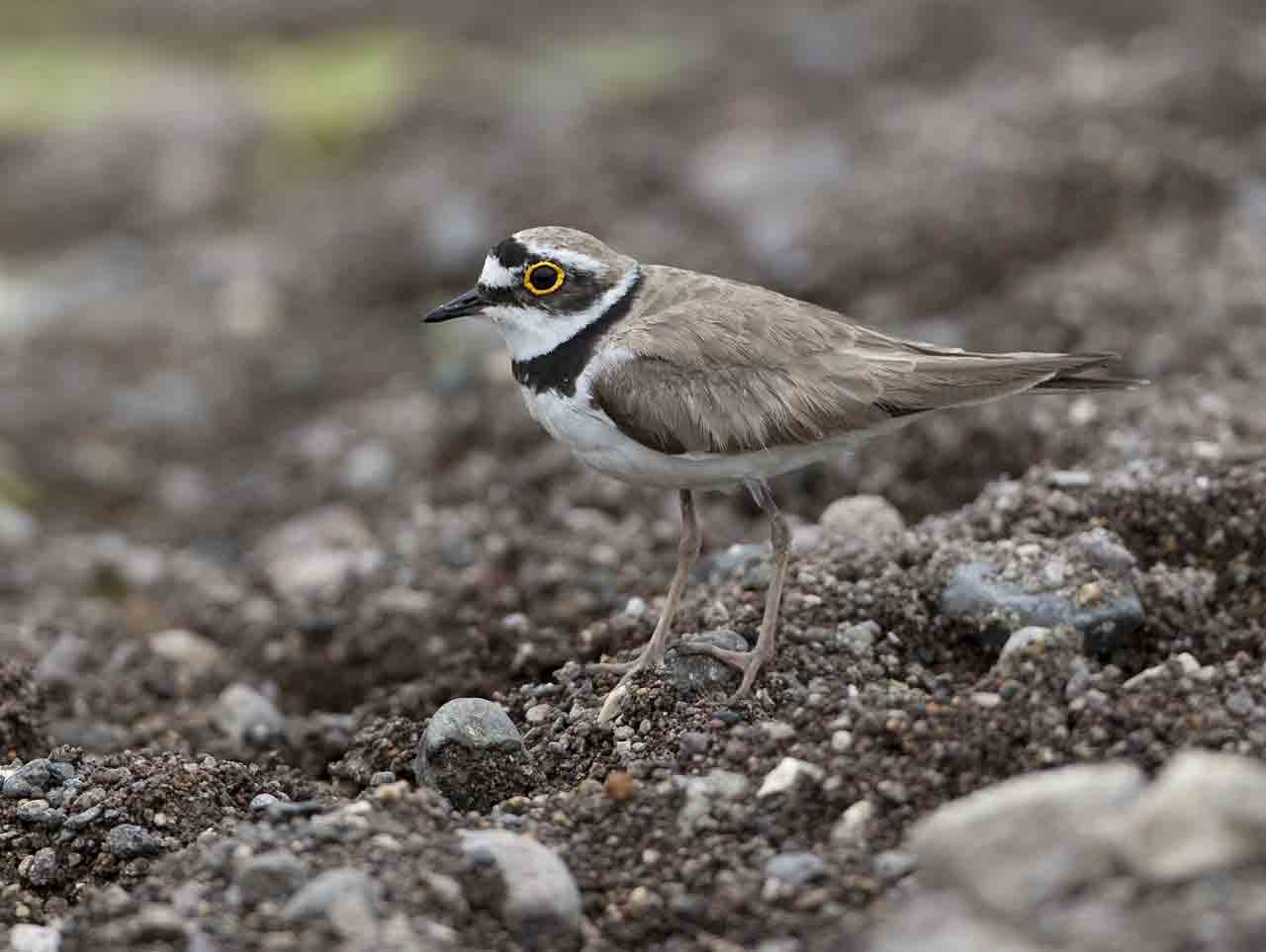
Little ringed plover. Photo: Klaus Dichmann
Bøtø Nor
South Falster
Important staging site for birds on autumn migration, including geese, ducks, waders and cranes
See Google map with bird observation towers, car park, etc.
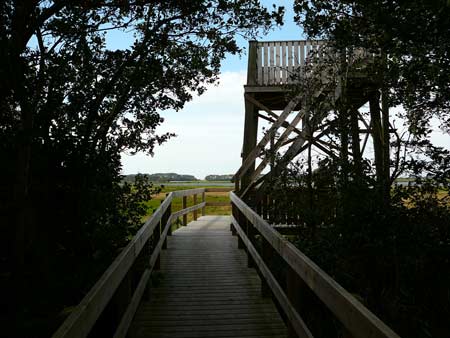
Bøtø Nor observation tower. Photo: Joy Klein
Description:
The bird reserve at Bøtø Nor is what is left of a much larger, shallow coastal lagoon that once lay between the moraine landscape on the western side of south Falster and the present long, straight beach on the east. The lagoon was then 15km long and surrounded by reedbeds and meadows. In 1860 it was decided to drain the area, and dykes, canals and a pump station were constructed. However, the work was destroyed by the enormous flood in 1872, and the project had to be started from scratch. This time the drainage project was a success and the area now comprises arable land, extensive holiday cottage areas, and plantations. A pump station at Marrebæk leads the water from the canals out into the sound of Guldborgsund.
Only the central part of the original Bøtø Nor has been preserved as a bird reserve. In 2015 it consisted of a 200ha stretch of land, which has now been increased to nearly 400 ha, thanks to the Danish Nature Fund's purchase of 140 ha agricultural land. The Fund has also purchased half of Bøtø forest, so that the whole area now covers around 500 ha. Bøtø Nor itself consists of meadows, reedbeds and ponds.
Birds:
Breeding birds:
Various species of duck breed in the reserve, including teal and mallard, and a few pairs of gadwall, shoveler and garganey. Greylag goose breed here regularly in ever-increasing numbers, and water rail, crane and up to three pairs of marsh harrier nest in the reedbeds. The local breeding pair of white-tailed eagle are seen daily in the area.
Migrating and staging birds:
In autumn, Bøtø Nor is an important staging area for migrants. Greylag goose, white-fronted goose, barnacle goose, gadwall, teal, mallard, pintail, garganey, shoveler and occasionally Bewick's swan can be seen on the ponds. Many waders appear on the reserve during the migration period, when large flocks of golden plover and lapwing are seen, together with smaller flocks of curlew sandpiper, ruff, spotted redshank, greenshank and wood sandpiper. Red-necked phalarope is spotted fairly regularly in Bøtø Nor in August/September.
A few non-breeding cranes sometimes stay here in summer, but larger numbers can be seen during autumn migration. During the day they feed on the surrounding fields but spend the night in the reserve.
In winter, the surrounding fields host large flocks of greylag geese, bean geese, white-fronted geese and barnacle geese, and a fair number of whooper swans can often be seen. Pink-footed geese are seen more and more often and in increasing numbers. The rare red-breasted goose has been seen on a few occasions.
White-tailed eagles are seen regularly all year round, as they nest in the adjoining Bøtø Plantage. Peregrines are spotted very often during the migration periods and in winter. Migrating hobbies pass over the area in autumn, and in winter hen harrier can be observed, flying over the reedbeds and the fields.
Now and again rarities appear. In summer 2009, for example, little egret was seen, and great white egret turns up more and more regularly, sometimes even in small flocks. In summer Savi's warbler and great reed warbler are sometimes heard in the area.
Other animals:
The reserve is an important locality for amphibians. Apart from toads, there are populations of the rare natterjack toad (Epidalea calamita, formerly Bufo calamita) and European green toad (Bufo viridis). On quiet evenings just after sunset in May/June one can hear a fascinating chorus of croaking frogs of all three species.
Visiting and access:
On route E55 between Nykøbing and Gedser, turn off in Marrebæk towards Bøtø. Where the road ends in a T-junction, turn right along Bøtø Ringvej (ring road). There are a bird hide and a bird observation tower with good views over the area from the eastern side of the reserve. The hide is reached by turning right along Trevlekronevej and continuing to the end of the road. The hide is covered and is suitable for wheelchairs. The tower is reached by driving further along the ring road (going south) and then turning right along Tidselvej and continuing to the end. At the tower there is also a disabled-friendly ramp and a viewing platform. (There are plans to erect a new tower in the near future). There are signs to both viewpoints (‘Fugletårn’) on the ring road. One can drive from one to the other along Lævej. There are small car parks at both towers. Another possibility is to follow route E55 southwards. Just after a lay-by south of Marrebæk one can turn left onto a gravel track (not clearly signposted) which crosses the fields left of the road. After around 500m one reaches a small car park from which there is access to the third and newest observation tower in the area. The route is marked and there is just over one kilometer to the tower, which is very well situated for observing the birds at short distance. It is not, however, suitable for wheelchairs.
To explore Bøtø Nor on foot, one can follow a 15 km long network of paths and gravel tracks around the area. They can be accessed from all three observation towers, where there are information boards showing the route.
The large flocks of geese in the winter months are best seen from the E55 road between Marrebæk and Gedser. There are several car parks along the road.
South of the bird reserve is Bøtø Forest, which is south Falster’s largest forest, where one can go for a circular walk on marked trails. A few years ago, the Danish Nature Fund purchased half of the forest and as a result it has changed character completely: formerly dominated by conifers, it has now many deciduous trees, with many open spaces and ponds. A little group of wild konik ponies and free-roving cattle have been introduced to keep down the vegetation. White-tailed eagle nest in the forest, as already mentioned, together with buzzard, sparrowhawk, kestrel and firecrest. The forest can be accessed from the large car park at the southern end of Bøtø Ringvej, where there are also toilets.
Even further south is Gedesby, a village with half-timbered farmhouses that were reconstructed after the flood in 1872. To the north is Marrebæk, where the old pump station is now a museum with pumping machinery.
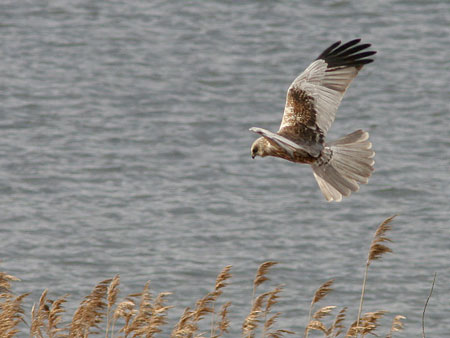
Marsh harrier. Photo: Klaus Malling Olsen
Gedser Odde
The southernmost point of Denmark
A phenomenal spring migration of ducks, raptors and passerines, impressive ringing results spring and autumn, and exciting surprises in summer. Welcome to Denmark's most attractive bird station!
See Google map with look-out points, car parks, etc.
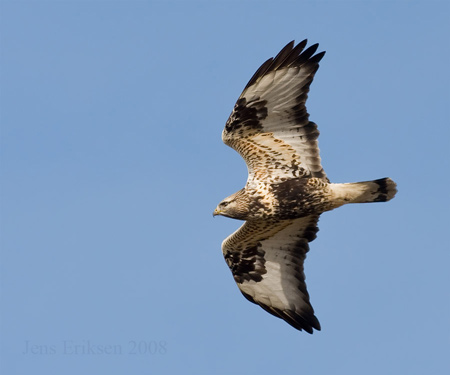
Description:
The spit of Gedser Odde is situated at the point where Scandinavia stops and mid-Europe begins. The coast has steep - and geologically interesting - slopes going down to the beach, with flat farmland behind. The best place to watch migration over sea and land is at the southernmost point of the spit. Next to the lighthouse is the former lighthouse assistant's house, now renovated and home to Gedser bird station. Round it is a large garden, that attracts many passerines during a great part of the year.
Birds:
From the spit one can watch the sea migration, that is often quite considerable, especially on days with strong on-shore winds. This is mainly an autumn phenomenon. Gedser is best known for its many eiders, that can move past the spit in great concentrations. This migration takes place both in spring (around end March/beginning April) and in autumn. The spring migration of eiders is best seen from Kroghage at Gedser and Sdr. Boulevard, as the birds come from a west-south-west direction. Common scoter can be seen all year round: on some days over 5,000 individuals fly past Gedser Odde. In autumn, geese can be seen in their thousands, both flying past and stopping over, and there are many migrating divers, especially red-throated diver, that can reach numbers of 1,000 on the best days. With a little luck and patience, one can in autumn see all four species of skua, arctic skua being the most common with up to two-figure numbers on a good day. Gedser Odde is probably the locality in Denmark with highest numbers of migrating little gull both spring and autumn – every year that are some days with over 500 migrating birds and in autumn a total of around 10,000 fly past. In the winter season, long-tailed duck can be seen and heard from Sdr. Boulevard.
The area is also known for migrating raptors. Numbers vary considerably, dependent on wind direction. Migration can best be seen from the southernmost point or at the car park, when the wind is coming from the south or south-east, but along the whole stretch from the southernmost point and up to the marina at Gedser one can see raptors that are either resting or flying out over the Baltic Sea. Autumn days with sudden shifts in wind direction to north-west can give exceptionally high figures. Rough-legged buzzard is a species that migrates south-east in autumn, and that is why Gedser Odde is probably the country’s best autumn migration locality for this species. In addition, red kite, marsh harrier, buzzard and other raptors are seen in good numbers every year.
Many passerines migrate over the area, and following these come sparrowhawks – on the hunt. Early autumn, yellow wagtail are seen on the fields around the south spit. The migrating passerines can best be heard from the car park, where the sound of the waves is less audible. Every year there are several days when large mixed finch flocks, mainly chaffinch and brambling, pass by the spit – days with 30-50,000 birds are not unusual. Wood pigeon migration is even more dependent on wind direction, as around 80% pigeons fly out over the sea from southern Lolland, but at Gedser Odde there can be a few days every year when over 30,000 pigeons migrate. The pigeons can usually best be seen from Kroghage and the marina.
As at all good migratory spots, there are also chances of spotting rarities. In the last few years, due to increased observation activity, the following very rare and unusual bird species have been observed: Leach's petrel, litle egret, black stork, glossy ibis, stellers eider, short-toed eagle, Bonelli's eagle, spotted eagle, lesser spotted eagle, Eleonora's falcon, gyr falcon, citrine wagtail, eye-browed thrush, Blyth’s reed warbler, paddyfield warbler, great reed warbler, olivaceous warbler, greenish warbler, arctic warbler, Pallas’s leaf warbler, dusky warbler and rock bunting, whilst birds such as black kite and firecrest are seen in double numbers on the best days. Gedser is also probably the best locality in the country to visit if one has hopes of finding a barred warbler.
Visiting and access:
Route E55 connects Nykøbing Falster to the town of Gedser. In the town, turn left onto Langgade. The road continues as Sdr. Boulevard and then as Gedser Fyrvej. By driving past the lighthouse one reaches a large car park near the beach. From here, one can walk further east to the old naval station (now rebuilt as an exhibition building) (follow the sign for "Sydstenen" which is the large stone marking Denmark's most southernly point). One can also go back to the bird station, which is the thatched building next to the lighthouse. The nearest public toilet is in the exhibition building. The toilet is open during the daytime. N.B. The exhibition building can only be reached on foot from the car park.
Gedser bird station carries out standardized ringing in the garden around the station. Ringing takes place from 1st March to 15th June and again from 20th July to 15th November. The station and surrounding area is owned by the Nature Agency. There is admittance for the public to the station: access is along the path from the car park to the thatched cottage. Apart from ringing passerines, the bird station carries out standardized counts of the migrating birds that fly past and over Gedser Odde. This registration takes place throughout autumn, from August to December.
Gedser bird station is one of the localities in Denmark that rings the greatest number of birds - an impressive number in spring and a remarkable number and variety of birds in autumn.
There are a few rules that must be kept if visiting the station garden: all visitors are asked to keep on the wide path that crosses the garden and goes round the cottage. It is not permitted to go over to the nets.
The staff are specially trained in releasing the birds from the nets and in handling them correctly. If you wish to speak to the ringer, and he/she is not to be seen at the station, please sit down on the bench in front of the main building until he/she comes back from seeing to the nets.
Gedser bird station has an Open House arrangement at least twice a year. In spring, it takes place some time in April/May and in autumn it is usually the last Sunday in September. In addition, several walks are organized, for example in connection with the eider migration or with raptor migration. The bird station’s English-language website can be downloaded here.
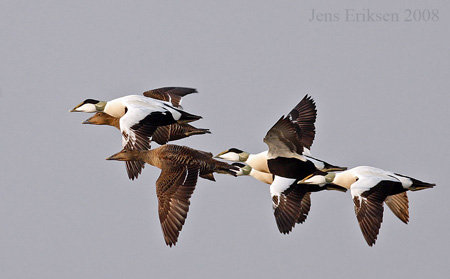
Eiders. Photo: Jens Eriksen
Hyllekrog-Saksfjed
South Lolland
Hyllekrog-Saksfjed is one of the most important areas in south-eastern Denmark for migrating raptors and staging waders, geese and swans
See Google map with look-out points, car parks etc.
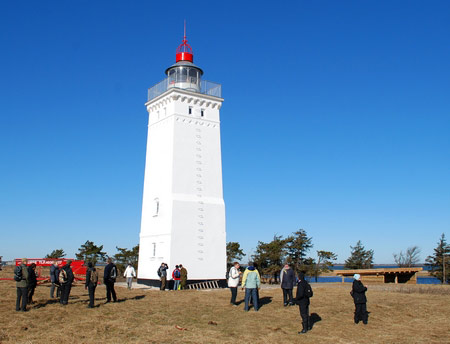
Description:
Saksfjed Inddæmning is the drained bed of a fjord situated behind the Baltic Sea dyke towards the south. The dyke was built after a huge flood in 1872 had put half of south Lolland under water. To the east is the 5km long Hyllekrog spit. Between the spit and the mainland is an area with shallow water.
Hyllekrog and part of the Saksfjed Inddæmning is owned by the Bird Protection Foundation and is one of its largest reserves, with 163ha deciduous woodland, coastal meadow and sand dunes. The area is managed, and the meadows are grazed to ensure a richer and more varied flora and better breeding conditions for waders. A fence has now been put up across the neck of the spit, partly to turn the area into one large grazing meadow, partly to prevent foxes from destroying the nests of the breeding birds.
During the last few years, a great deal of the management scheme for the area, made up by the Bird Protection Foundation, has been implemented. This has meant that the meadow areas have been enlarged and are now grazed, and that larger areas are under water for part of the year, for the benefit of ducks, gulls and waders especially. Black-headed gull have recently formed colonies both on Hyllekrog and in the Saksfjed Inddæmning. In October 2022, the Hempel Fund purchased 775 ha natural and agricultural land in the Saksfjed Inddæmning with the aim to converting it - over time - to one of the most important natural areas in Denmark. This area is neighbour to the Saksfjed-Hyllekrog nature reserve.
Birds:
Breeding birds:
The reserve houses nearly 75 different bird species in summer, including quite uncommon birds such as gadwall, garganey and red-backed shrike, and in 2012 a pair of stonechat bred here for the first time. In 2010 a pair of white-tailed eagle settled down in the reserve and in 2011 they successfully reared two young. The eagles are still nesting here. Although the Hyllekrog spit is closed for access in the breeding season, many birds can be spotted in the lagoons along the dyke, in the woods and on the meadows.
Migrating and staging birds:
The main attraction at Hyllekrog-Saksfjed used to be the autumn migration of raptors, but since a considerable spring migration of especially waterbirds through the Femern Belt was first noticed in 2008, this is also a phenomenon that can make the spot worth visiting.
In spring, large flocks of eider (March/April), curlew (mid-April), barnacle goose (mid-May) and brent goose (late May) can pass close to the coast, which is an impressive experience. Raptors, in more modest numbers, come in from the Femern Belt in westerly winds, with buzzard and sparrowhawk predominating. This is also the spot for seeing by far the largest spring migration of little gull in the country (late April) and many terns - especially arctic terns and common terns (April/May), together with black tern (May) if one is lucky.
In autumn, the raptors are still the great attraction: on a good day at the end of August/beginning of September hundres of honey buzzards can be seen migrating together with ospreys and marsh harriers. Later on, red kite, buzzard, sparrowhawk, hen harriers and various falcons appear.
At the end of August, migrating yellow wagtails can be spotted, followed by hirundines, white wagtails and pipits. In October, enormous flocks of woodpigeons, interspersed with stock doves, fly past - sometimes together with many finches in large, mixed flocks.
Staging ducks and waders can best be seen in spring and autumn from the observation tower at Billitse Mølle (mill) (which despite its name is a fully automatic, electrically powered pump station). A wide variety of various dabbling ducks, including garganey, can be seen here. Waders include avocets, which breed on the islets in the lake near the tower, together with foraging lapwings and various Tringa species. If you walk along the spit you may meet grey plover and turnstone.
In late summer, the population of mute swan in the shallow waters may be increased to around 10,000 birds, which stage here to moult. Hyllekrog-Saksfjed is thereby one of the most important moulting localities for swans in Denmark.
Other animals:
The locality is also well known for butterfly migration, including red admiral (Vanessa atalanta) that migrates over the sea on warm, windless days in August and September. Amphibians include agile frog (Rana dalmatina) and edible frog (Rana esculenta), which are common, while green toad (Bufo viridis) can be found in the ponds and bogs on Hyllekrog. Common seal can be seen on Hyllekrog and with any luck grey seal. In the area behind the dyke there is a large population of fallow deer.
Visiting and access:
From junction 49 on the E4/E47 drive towards Holeby, then drive south along Højbygårdsvej (signs to Tågerup/Lungholm etc.). Turn left at the T-junction just south of Tågerup. After passing the estate of Lungholm Gods to the left, turn right onto Bjernæsvej (signs to Brunddrag/Naturreservat). After 4km (at a sharp left-hand bend) the road changes its name to Lyttesholmvej. A little further on at a stone barn, the road becomes a gravel track. Turn right at the barn and follow the track for another 2km to reach the car park at Store Brunddrag. Here there is a public toilet. A little further eastwards is another car park with an information board and folders with information about the reserve. From here one can walk out to the Hyllekrog spit. There is another car park at the north of the reserve which can be reached via the villages of Errindlev and Sjælstofte. From Errindlev, turn south along Sjælstoftevej and in Sjælstofte turn south again along Fælledvej, from where there are signs to the reserve.
The best times to visit the area are spring, late summer and autumn. There is no access to the Hyllekrog spit in the breeding season 1st March – 15th July. Outside the breeding season, it is possible to walk out to the end of the spit, and there is also access to the the lighthouse, which has recently been renovated (2012) and is owned by the Nature Agency. In the lighthouse is a little exhibition with information about Hyllekrog's natural and cultural history. One can also climb up to the top of the lighthouse and enjoy the fine view. Access is at one's own risk. Please note that no more than six people are allowed up in the lighthouse at one time.
Autumn migration can be seen from various spots along the dyke. Please note that one should use the steps leading to the beach and not walk on the dunes, as they are part of the dyke system and must not be eroded.
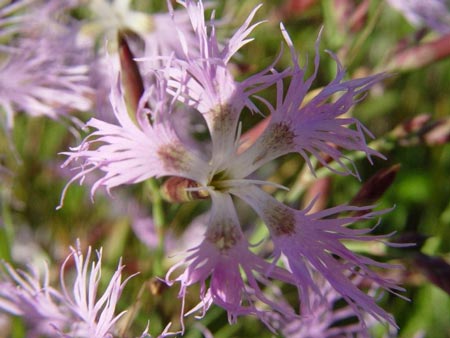
Large pink (Dianthus superbus) at Hyllekrog. Photo: Uffe B. Nielsen
Kalløgrå
Lolland, north of Sakskøbing
Lolland-Falster’s most important site for ducks and waders
See Google map with bird observation tower, car parks etc.
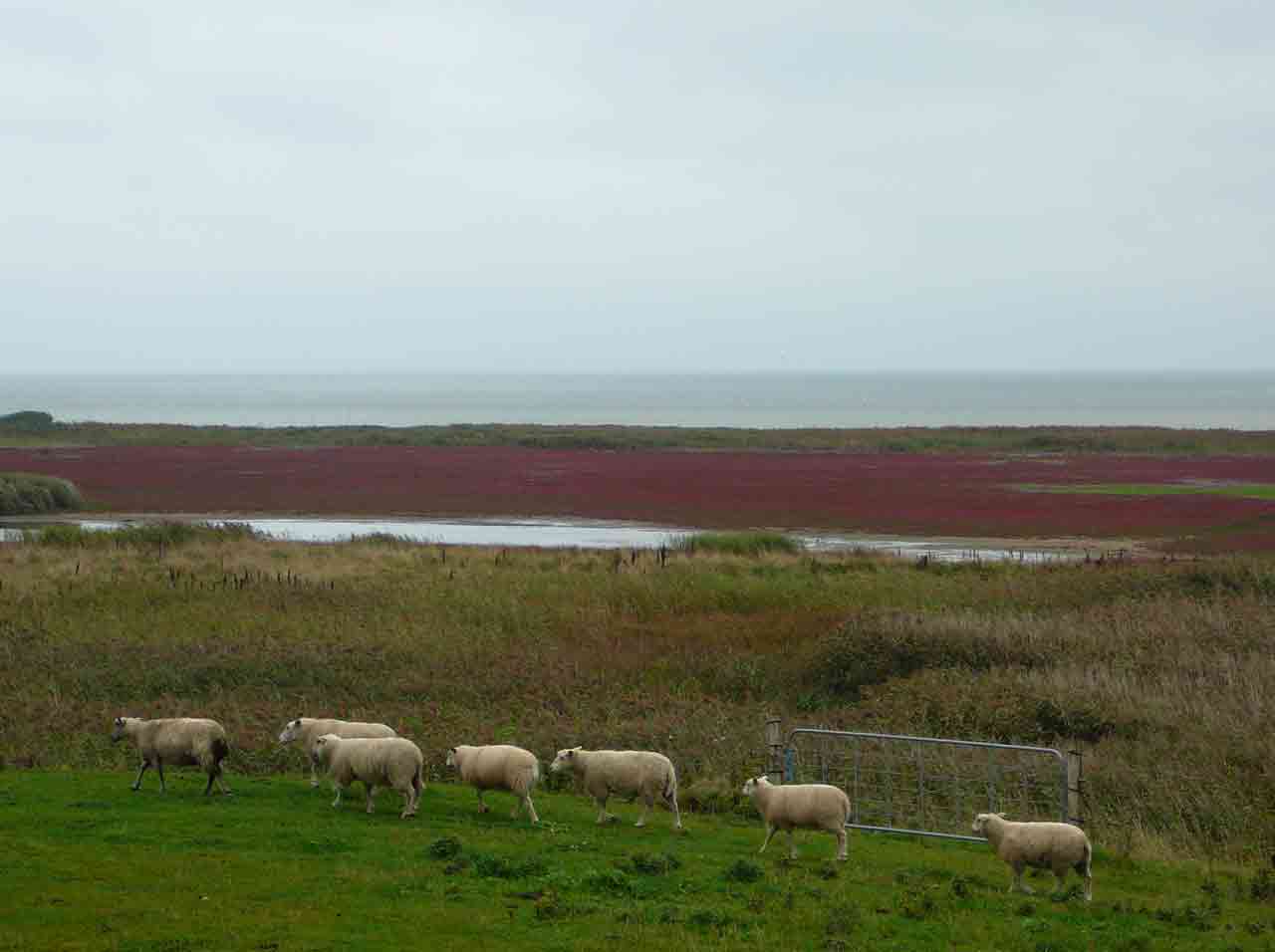
Kalløgrå. Photo: Joy Klein
Description:
Kalløgrå is a cove off the north coast of the island of Lolland. The water in the cove is shallow and surrounded by meadows. The area was used to deposit sludge from the sugar factory in Sakskøbing for a period of 10 years. In 2003 around 30ha of the area was taken over by the Aage V. Jensen Fund and a thorough re-establishment project was carried out, so that the area is now a wetland with lakes, wet and dry meadows - some of which are grazed - and remains of embankments.
Birds:
Breeding birds:
Several wader species breed at Kalløgrå, for example lapwing, redshank and oystercatcher. A fair-sized colony of avocet and a small colony of black-headed gull can be seen on the islet in the lake. Common gull, arctic tern and common tern nest here, too. Breeding duck species include mute swan, shelduck, gadwall, mallard and tufted duck. There are also a few pairs of little grebe and several pairs of red-necked grebe. Great crested grebe bred here for the first time in 2017. A number of coots breed here too. A pair of marsh harriers nest in the reedbeds, which also house marsh warbler, reed warbler, bearded tit and reed bunting. Water rail can be heard regularly. Bittern was observed for the first time in 2011 and has now and again been heard in the breeding season. A few pairs of yellow wagtail breed on the meadow.
Migrating and staging birds:
The area is a good stop-over site for many species of ducks and waders. Greylag goose can be seen throughout the year, being most numerous in spring and autumn, and in winter there are flocks of barnacle goose. During spring and autumn migration, Kalløgrå acts as a staging post for several duck species, for example wigeon, gadwall, teal, pintail and tufted duck. A few garganey can be seen in spring.
In autumn, large numbers of avocet, golden plover, dunlin and curlew, and smaller numbers of grey plover, little stint, curlew sandpiper, snipe, spotted redshank and greenshank stop over here. A few broad-billed sandpipers turn up in autumn.
Other birds that can be observed here are sand martins, that roost in the reedbeds in late summer, and peregrine, that appear now and again. White-tailed eagle can be seen regularly throughout the year and daily during the winter months. Hen harrier is common in winter.
More unusual birds include great white egret, which has recently started to turn up every year in May. In 2017, it also arrived in October and was a stable guest here all winter. Mediterranean gull bred here in 2021.
Visiting and access:
From route 153 between Sakskøbing and Guldborg, drive north to Kallø. Drive into the village and then north along Kalløgråvej, which becomes a gravel road. By continuing along this road one reaches a sheep fence, where one can park. From here there is access to a bird observation tower, from which there is a splended view over the area.
Walking or cycling inside the fences is permitted, but please keep to the paths in order not to disturb the staging and breeding birds.
When visiting Kalløgrå, one can take the opportunity to visit Fladet, which is a cove cut off from the sea by a dyke. The area is a state-owned reserve with a lake, reedbeds, grazed meadows, thicket and hedgerows. A bird observation tower offers a view over the whole area. Fladet can be reached by taking Skovbyvej leading north-west out of the village of Tårs. There are signs to the bird observation tower. There is no access to the reserve itself throughout the year.
One can also continue further along Skovbyvej in the direction of Kalløgrå. Where Skovbyvej ends there is a gravel road which turns off sharply to the right, and after around 200m there is a car park. From here one can walk around 100m to the east, enter the sheep fold and walk up a path to reach the tower at Kalløgrå. This access has the advantage that both reserves can be visited on the same trip.
Whatever the time of year it is a good idea to look up the homepage of the Danish Meteorological Office, which can be downloaded here, and check the tides before a visit. If the sea level is normal or low, Kalløgrå is full of life, but it is almost empty at high sea level.
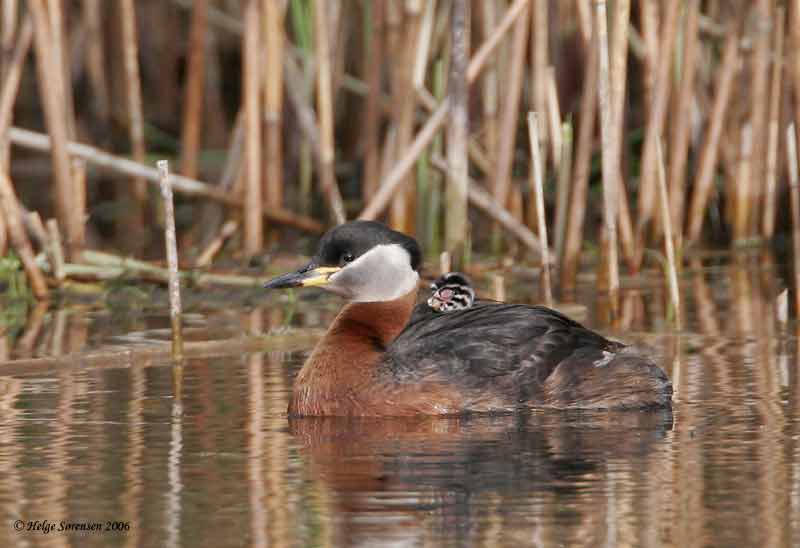
Red-necked grebe. Photo: Helge Sørensen
Majbølle Nor
North coast of Lolland
One of Lolland’s most important staging and wintering sites for waterbirds.
See Google map with bird observation tower, car park etc.
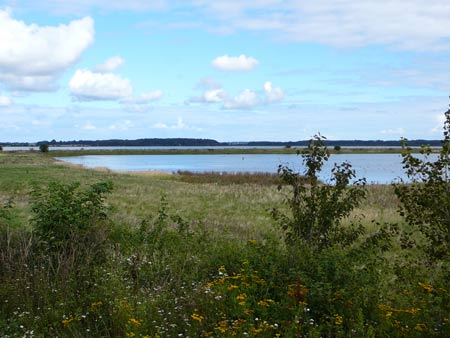
Description:
Majbølle Nor is a bird reserve on the east coast of Lolland immediately west of the Guldborgsund tunnel. It covers an area of 34ha, of which 21ha are under water. The original Majbølle Nor was dammed in 1923 and the many meadows were converted into arable land. When the motorway tunnel under the Guldborgsund was built in 1985, 34ha of the arable land was used to deposit the mud that was dug out. The area was taken over by the authorities in 1988, and in 1991 was fenced in and made into a bird reserve. It has gradually developed into a natural coastal meadow and is grazed by cattle. A bird observation tower has been built on the south side of the reserve and affords a good view over the area.
Birds:
Breeding birds:
The reserve supports breeding little grebe, mute swan, greylag goose, shelduck, gadwall, mallard and shoveler. Breeding waders include avocet and redshank. Marsh harrier nest in the reedbeds, and skylarks, meadow pipits and yellow wagtails nest on the meadows.
Migrating and staging birds:
The area attracts many waterbirds that stop over here during migration. Some stay here throughout the year, for example greylag goose, that can congregate in large flocks, especially in autumn. On the lakes, shelduck, wigeon, gadwall, teal, mallard, shoveler, pochard and tufted duck can be seen. Most of the species of wader to be seen in Denmark can be observed here, but only in limited numbers. These include oystercatcher, avocet, ringed plover, ruff and redshank, together with calidris and tringa species. Red-necked phalarope is a yearly guest. Large flocks of lapwing and golden plover stop over here, especially in autumn. Flocks of barnacle geese appear in autumn, and in winter whooper swan, goosander and scaup can be seen.
Raptors seen over the reserve include white-tailed eagle, buzzard, kestrel and peregrine. Marsh harrier can be seen during the summer months and hen harrier is a winter guest.
Visiting and access:
The village of Majbølle is situated immediately north of the E47 motorway at the Guldborgsund. At the northern end of the village, on Norvej, a signpost indicates the way to the bird reserve along a road leading east towards Guldborgsund. The bird reserve is right beside the motorway. The road out to the bird reserve is long and winding. First one passes a little harbour and from here a narrow gravel track continues for a few kilometers next to a dyke. Finally one reaches a little car-park, just before the motorway. A path leads up to a bird observation tower and a picnic table. From the tower there is an excellent view over the shallow lakes and the meadows. In very wet periods one needs to wear rubber boots to reach the tower from the car-park.
One can also walk along the track that follows the east side of the reserve, next to the motorway. From here, the water and meadows can be observed from a different angle.
It is a good idea to watch out for shrikes when driving to the car-park – red-backed shrikes in summer and great grey shrikes in the winter months. It is also recommended to stop at the pump station in winter, where there is a chance of spotting a kingfisher - a bird rarely seen in this area.
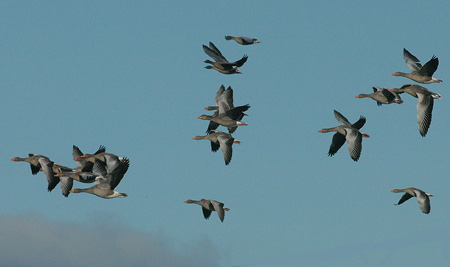
Greylag geese. Photo: Albert Steen-Hansen
The Maribo lakes
Lolland
Breeding white-tailed eagle, cormorant, red-crested pochard and grey heron. Staging geese and ducks. Denmark’s most important locality for gadwall.
See Google map with look-out points, bird observation towers, car parks, etc.
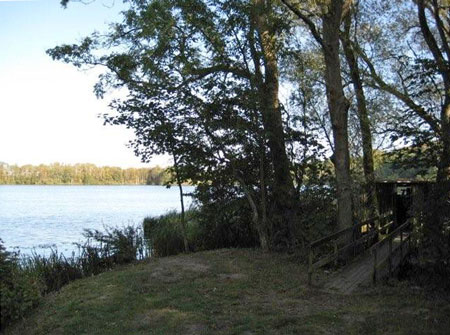
Hejrede Sø - bird-hide on the western bank. Photo: Lars Munk
Description:
There are four lakes at Maribo: Søndersø, Røgbølle Sø and Hejrede Sø south-east of the town and the smaller Nørresø situated north-west of the town and split in two by the motorway embankment. In contrast to the rest of Lolland, which is flat and cultivated, the area is fairly hilly and covered with fields and woods. The landscape here was formed by melting ice after the last ice age. This has created the lakes, that have winding coastlines with inlets, promontories and islets. They are surrounded by reedbeds, grazed meadows and woodland. Unfortunately, the quality of the water in the lakes is unsatisfactory.
In October 2019. the Aage V. Jensen Naturfond purchased 1130 ha at the Søholt estate. It is planned to let nature takes its course, stop drainage, and carry out a uniform management plan for the whole area.
Birds:
Breeding birds:
White-tailed eagle have bred successfully at the Maribo lakes every year since 1997. The nesting tree broke in a storm in 1999, after which the eagles built two new nests in the same part of the wood. There are always both old and young eagles at the lakes. The best chance of seeing them is at the meadows next to Søholtvej or from the bird hide between Søndersø and Hejrede Sø.
On the islets of Askø and Lindø in the Søndersø lake there are mixed colonies of cormorant (around 750 pairs) and grey heron (200-300 breeding pairs). On the lakes are great crested grebe, red-necked grebe, mallard, shoveler, pochard and tufted duck. There is a large breeding population of greylag goose, and the lakes have Denmark’s largest population of gadwall. A few pairs of red-crested pochard have nested at the lakes since 2003 and can be seen most of the year, sometimes two or three at a time in the large flocks of other ducks. Marsh harrier nests in the reedbeds. In summer, the reeds are full of birdsong, including sedge warbler, reed warbler and reed bunting.
Migrating and staging birds:
The Maribo lakes are an important staging locality for many geese and ducks. Greylag goose is seen here in large flocks all year round. Other species of geese can be seen here in the winter months especially. In winter, some of the largest flocks of gadwall in Denmark are seen here, with around 1000 birds. In addition, there are large flocks of other ducks, especially pochard and tufted duck, with several thousand birds. Smew and goosander stage in fair numbers and coots often congregate in large flocks. The many ducks, coots and cormorants are a larder for white-tailed eagles! Many young white-tailed eagles can therefore be seen at the lakes throughout the year, as long as they are not all frozen over. These young eagles can be the offspring of local pairs, or can be eagles from Germany or Sweden that fly some distances while young, until they find a mate and a suitable nesting site.
Osprey can often be seen hunting over the lakes during the spring and autumn migration seasons. More uncommon birds that can be spotted include white-winged black tern, that has turned up every spring for the last few years, great white egret, Savi’s warbler and great reed warbler.
Visiting and access:
From the E4 motorway between Sakskøbing and Rødbyhavn, turn off at junction 47 and follow signs to Maribo. From the town, the lakes stretch out south. There is only direct access to the lakes on paths through the woods, but on the surrounding roads there are several places from where one can look out over the water. The following outlook points/car parks are easy to access (see the Google map):
1) Bird observation tower in the Kidnakken wood. There is parking space by the wood at the end of Meinckesvej, near the open air museum (Frilandsmuseet). In Maribo there are signs to the open air museum, and from the museum there are signs to the tower. A path goes through the wood and all the way to the Nature School
2) The Nature School on the western bank of Søndersø is one of the easiest places to reach the lake, as it is state owned. Here there is a car park, but one can also get here on a walking/cycle trail from Maribo. At the school are picnic tables, including two that are accessible with a wheelchair, a barbecue and a disabled toilet on the west side of the school.
3) West of the estate of Søholt Gods, south of Søndersø, the meadows north and south of the road are staging localities for greylag goose in autumn. One can park at a lay-by/car park at the side of the road.
4) One can also park at a car park to the east of the Søholt gardens.
5) Further to the south east on Søholtvej is a car park in the wood, which is ideal if one is planning a walk in the wooded area near the lake, for example out to Skelsnæs.
6) Not far from the T-junction at Frederikshusvej/Røgbøllevej is a lay-by with picnic facilities and a view across Røgbølle Lake.
7) At the southern end of Røgbølle Lake, on the road between Bøsserup and Sørup, is a covered bird observation tower with a view over the lake. One can park at the car park just west of Sørup. Here, there is a toilet, a picnic table, and a ramp with a platform that is suitable for wheelchairs. Here it is possible to come right out to the edge of the lake. The tower is a little further on to the right.
8) At Hejrede Lake, where the road passes between this lake and the eastern end of Søndersø, there is a bird hide. Here there is a car park with picnic tables.
It is also possible (but difficult) to get close to the lake on one of the paths through the woods. Most of the woods are privately owned and regulations concerning access to private areas must therefore be respected.
There are several sights in the area, including Maribo cathedral north of Søndersø, the manor house of Søholt Gods, and a number of burial mounds and earthworks.
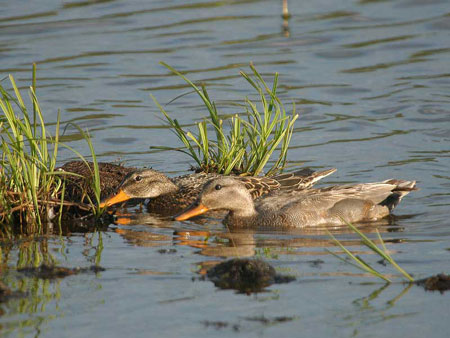
Gadwall. Photo: Albert Steen-Hansen
Møns Klint
East Møn
Breeding peregrine and forest birds, and spring migration in a unique natural environment
See Google map with look-out points, car parks etc.
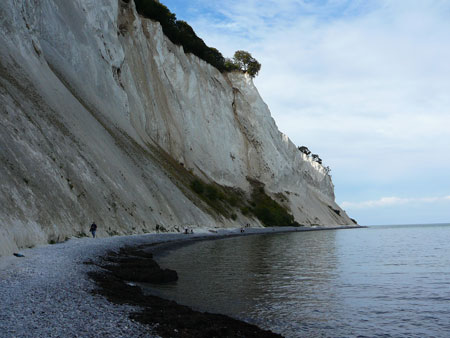
Møns Klint. Photo: Joy Klein
Description:
Høje Møn (High Møn) – the easternmost part of the island of Møn – was formed during the last ice age around 12,000 years ago, when the ice pushed enormous blocks of the former chalk seabed together. The highest point is now Aborrebjerg (143m). After the ice disappeared, there were many landslides along the coast, thus forming the high chalk cliffs. They are around 100m high along a stretch of around 5km. The cliff is still being eroded – at a speed of 2-4cm a year.
A large part of the area behind the cliff is covered by the forest of Klinteskov (800ha). It is partly privately owned and partly state-owned. Most of the state forest is a natural forest, where trees are not felled, and where trees that have fallen over are left to rot. North of the forest is Jydelejet, which is an attractive, hilly dry meadow area with groups of old beech trees, juniper and other bushes. The Aborrebjerg hill is situated in its southerly part. In clear weather, the Zealand coast at Stevns and the bridges between Møn and Zealand can be seen. At the edge of Jydelejet are three small lakes, that unfortunately are difficult to access. South-west of Klinteskoven are the two hills Høvblege and Mandemarke. South of the Klinteskov wood, the path between the wood and Møns lighthouse passes the Jættebrink ridge, from where there is a view across the whole of south-eastern Møn and out to the Baltic Sea. In clear weather the island of Rügen off the coast of northern Germany can be seen far away. In the whole area there are many rare plants that thrive on the chalky soil, including many species of orchid on the dry meadows (especially at Høvblege and the meadows adjoining Jættebrink).
Birds:
The area has interesting breeding birds and is a good spot for observing migrants.
Breeding birds:
Probably the most renowned bird species in the area is the peregrine. This bird used to nest at Møns Klint many years ago, but left the vicinity in 1972. In 2002 it began to nest again and has been successful every year since then; in fact several pairs now nest here. On the cliff face, house martins breed in large colonies, and sand martins have nesting holes where there are clay slopes. The forest supports many birds including buzzard, redstart and chiffchaff, but also more unusual species such as goosander, honey buzzard, woodcock, stock dove, bullfinch and hawfinch. Hobby, firecrest, pied flycatcher, golden oriole and raven breed intermittently or very rarely.
Red-backed shrike nest on the dry meadows (especially south of the forest at Høvblege and Bødkermosen and on the hills east of Stengården). Here there are 1-2 pairs of corn bunting. A new sensation is the reappearance of barred warbler on Møn - and thereby also in Denmark - after 24 years' absence. One pair bred successfully at Bødkermosen in 2022, and a pair with fledglings was spotted at Ulvshale in 2023. In or around the lakes at Jydelejet, and in nearby Langbjerg Mose, there are little grebe (irregularly), mute swan, greylag goose, tufted duck and black-headed gull. Goosander nests in the area and in the wood (chiefly in nesting boxes) or on the cliff in natural holes (but probably no more than one pair). The reedbeds and scrub house reed warbler, reed bunting, marsh warbler (rarely), thrush nightingale, goldfinch and other more common warblers.
Migrating birds:
The area is a good place from which to watch spring migration. Many species of raptor can be seen flying out over over the cliffs or stopping over in the area, including red kite (numbers of which have increased in the past few years, and which is now seen throughout the year), white-tailed eagle, marsh harrier, hen harrier, sparrowhawk, honey buzzard, buzzard, rough-legged buzzard, kestrel and hobby, but white stork and especially crane and barnacle goose are also seen regularly in large flocks.
There is a steady stream of passerines - both day migrators and night migrators - that often settle in the wood and on the dry meadows, and rare species such as wryneck, bluethroat and red-breasted flycatcher are sometimes seen. Ring ouzels can be seen in small flocks in springtime, especially at Jydelejet and at Høvblege. Greenish warbler can be heard nearly every year in the ravines at the cliff at the end of May and may perhaps breed here from time to time. Scarlet rosefinch has also been a yearly guest in and around Klinteskoven, but its numbers have been greatly reduced in the last few years.
Some of the rare birds that have been seen on migration are black stork, black kite, pallid harrier, Montagu’s harrier, little spotted eagle, red-footed falcon, bee eater, red-rumped swallow,thrush nightingale, collared flycatcher and ortulan bunting.
Other animals:
The rare large blue butterfly (Maculinea arion) can be found at Høvblege, which is the only place in Denmark it is seen. The butterfly is usually on the wing in July.
Visiting and access:
It is recommended to use the Nature Agency’s folder about Møns Klint that is available in English and can be downloaded here. You can also find the folder at the car park at the Møn lighthouse. With the map, it is easy to find the most interesting bird-watching sites, for example:
1) Store Klint. From the large car park (where there is a parking fee) at Store Klint and the Geo-Center, a stairway leads down to the beach. The peregrine usually nests in a little cave at the top of the cliff north of the stairway. It can also be seen from the beach at the bottom of the cliff, and is often seen flying over the rest of the area. From the car park, the tarmac road and several small marked paths lead further into the south part of the wood.
2) Aborrebjerg at Jydelejet is one of the best spots for watching spring migration, especially raptors.
3) Jættebrink is also a good spot, both for raptors and cranes flying in from the sea, for passerines passing along the coast, and for birds out at sea. Jættebrink can easily be reached from the path along the coast from the car park at Møns lighthouse.
4) Høvblege is also a popular site for watching spring migration and for enjoying the fine view and exceptional landscapes. The first (and only) Rüppell’s warbler ever seen in Denmark was spotted here in 1993 together with a subalpine warbler, and the area housed the last confirmed breeding pair of barred warbler in Denmark in 1998.
There is a comprehensive and state-of-the-art exhibition about Møns Klint's history, biology and geology at the Geo-Center next to the car park at Store Klint. There are also a cafeteria and toilets in the building, and at the reception desk one can purchase a folder about the birds in Klinteskoven. At Havrelukke in the north part of the wood between Store Klint and the entrance to the wood is a smaller car park, from where there are marked paths leading off.
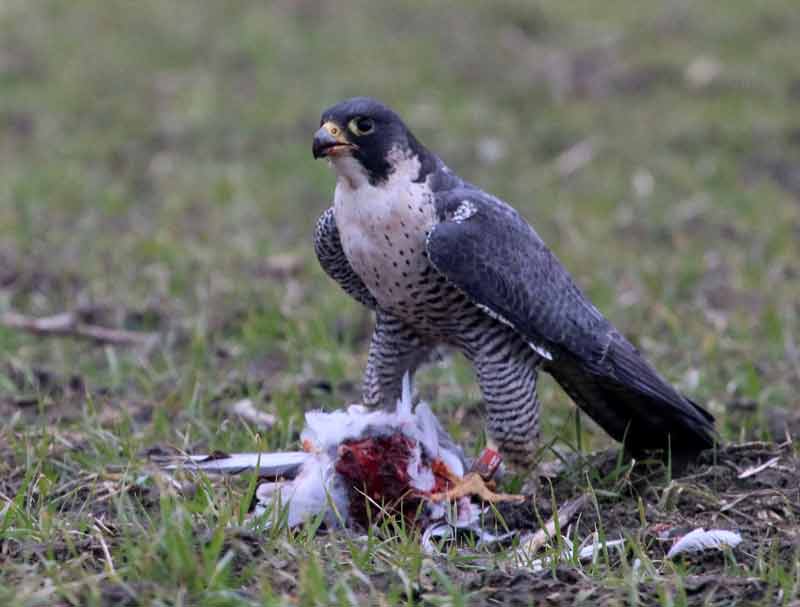
Nakskov Indrefjord
West Lolland
An excellent staging post for large flocks of swans, geese and ducks in autumn and winter. See google map for parking, outlook points, etc.
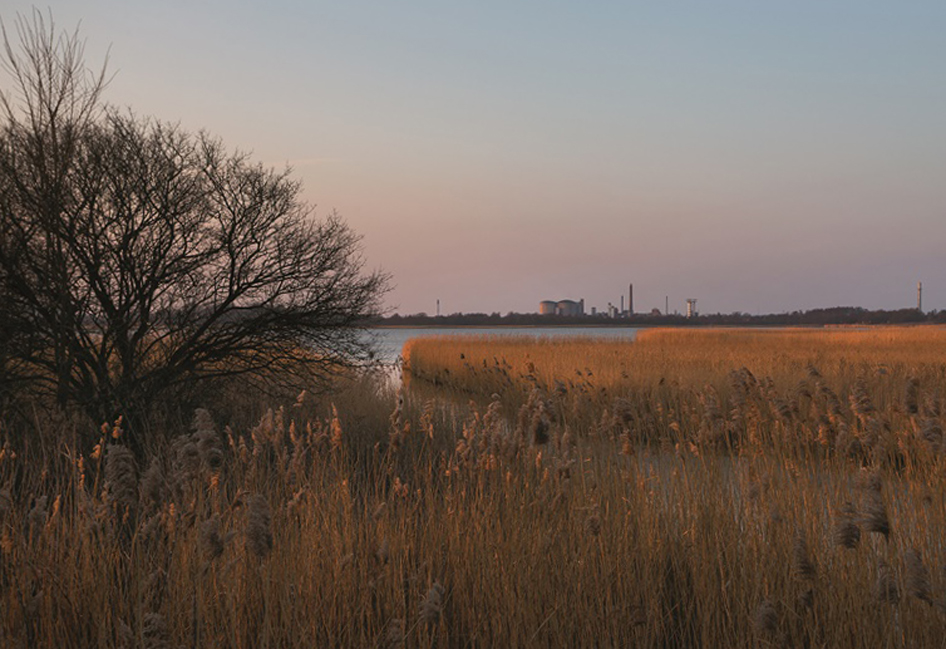
Nakskov Indrefjord. Photo: Bird Protection Foundation
Description:
Nakskov Indrefjord was originally part of Nakskov Fjord but after a sluice was built at the bridge in the town of Nakskov in the 1870’s, the water soon dropped in salinity and is now in effect a freshwater lake. The many artificial lakes and paths in the northern part of the area date from the opening of the sugar mill in 1882. The mill was allowed to use the water to wash sugar beet on condition that it created a recreational area for the town by laying down paths and planting trees. The artificial lakes with their luxuriant vegetation resemble a river landscape.
The Danish Bird Protection Foundation has owned 10 ha of the southern part of the fjord since 1987.
Birds:
Breeding birds:
There are opportunities for observing birdlife throughout the year. Breeding birds include little grebe, great crested grebe, mute swan, greylag goose, mallard, shoveler, pochard, goldeneye and coot. Marsh harrier nests in the reedbeds and can be seen foraging over the area in the summer months.
Bearded tit can be spotted throughout the year and several pairs breed in the reedbeds, which also house reed warbler, marsh warbler and reed bunting. Water rail is another species that can be found here. Kingfisher is spotted now and again, but it is not certain that it breeds here.
Migrating and staging birds:
Nakskov Indrefjord is a good locality for staging birds. Tufted duck is especially prominent (with up to 5000 birds autumn and winter), pochard (sometimes more than 1000 birds) and greylag goose, with several thousand birds staging here late summer and autumn. Small flocks of mute swan also congregate here. A few gadwall can be seen nearly all year round and now and again appear in small flocks. Coot can be seen throughout the year: in summer, especially, there can be flocks of several hundred birds and in some years even a few thousand. White-tailed eagle often flies overhead on its way to the fjord.
More unusual birds include great white egret (one individual staging here in autumn 2018 and again at the beginning of 2020), and red-crested pochard, which was seen here for a short period in spring 2018.
Visiting and access:
Route 291, which leads south out of the town of Nakskov, passes close to the northernmost part of Nakskov Indrefjord. One can park at Lienlund or at the pump station on Rødbyvej. From here there is access to a system of paths that cover a large part of the eastern side of the lake and also lead to a bridge crossing to the western side. From the bridge, the paths or the embankment around the lake there is a good view over the area. From the pump station at Holleby one can see over the southern section of the area.
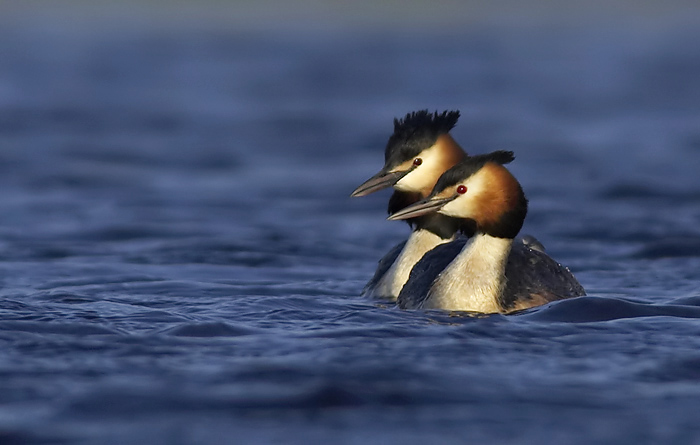
Great crested grebes. Photo: Gerner Mailandt
The Nyord meadows
Møn
One of the best bird localities in eastern Denmark. Very important area for ducks and waders, both as a staging post but also as a breeding site.
See Google map with bird observation towers, car parks etc.
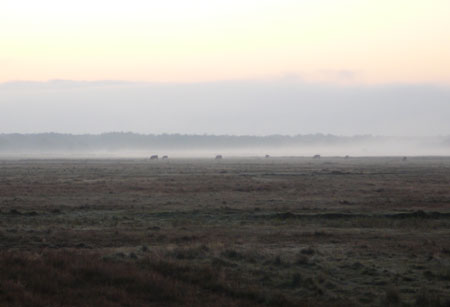
Description:
The meadows at Nyord, which cover 400ha of the island of Nyord on the northern coast of Møn, are one of the largest coastal meadow areas in the whole of eastern Denmark, and also boast a rich birdlife. The meadows have never been cultivated or drained. Nearly one half of the meadow area is owned by the Danish Bird Protection Foundation, which has been purchasing the meadows since 1971 to preserve them as one of Denmark’s most important sites for geese, ducks and waders. The Bird Protection Foundation manages the meadows to ensure the best possible conditions for the breeding waders, and have cattle graze the meadows in summer to ensure that the grass is kept short.
Breeding birds:
Several species of waders and ducks breed in the reserve. Waders include oystercatcher, ringed plover, avocet, lapwing and redshank. The last three species have experienced a significant increase in numbers during the last few years thanks to the management measures. The meadows here are one of the last sites in east Denmark where black-tailed godwit nest. Unfortunately, the number of breeding pairs has declined. Greylag goose, mallard, pintail and gadwall breed here. Passerines include skylark, meadow pipit, yellow wagtail and reed bunting.
Migrating and staging birds:
In autumn and winter, mute swans, geese, ducks and waders stage here in large numbers. Wigeon, shoveler, teal and pintail, especially, congregate in large flocks on the meadows and in the shallow waters around Nyord. Greylag goose and barnacle goose are the most numerous species of goose - barnacle goose has been spotted in flocks of up to 5,000-7,000 individuals. The meadows are a staging area for hundreds - sometimes thousands - of golden plovers and lapwings, starlings, swallows and sand martins.
Curlew and golden plovers often winter on the meadows. Raptors include kestrel, peregrine, rough-legged buzzard and hen harrier. In winter, an unusually large number of white-tailed eagles can regularly be seen on the meadows. Now and again small flocks of twite turn up.
From the town of Stege on Møn, a road leads north out of the town. Follow the signs to Ulvshale and Nyord. As soon as you have crossed the bridge, you have reached Nyord meadows.
The best view across the meadows is from the new two-storey bird observation tower in the middle of the meadows, where there are information boards and a platform with a ramp suitable for wheelchairs. A little further west there is a viewing platform at the Hyldevang nature centre, from where the south western part of the meadows can be seen.
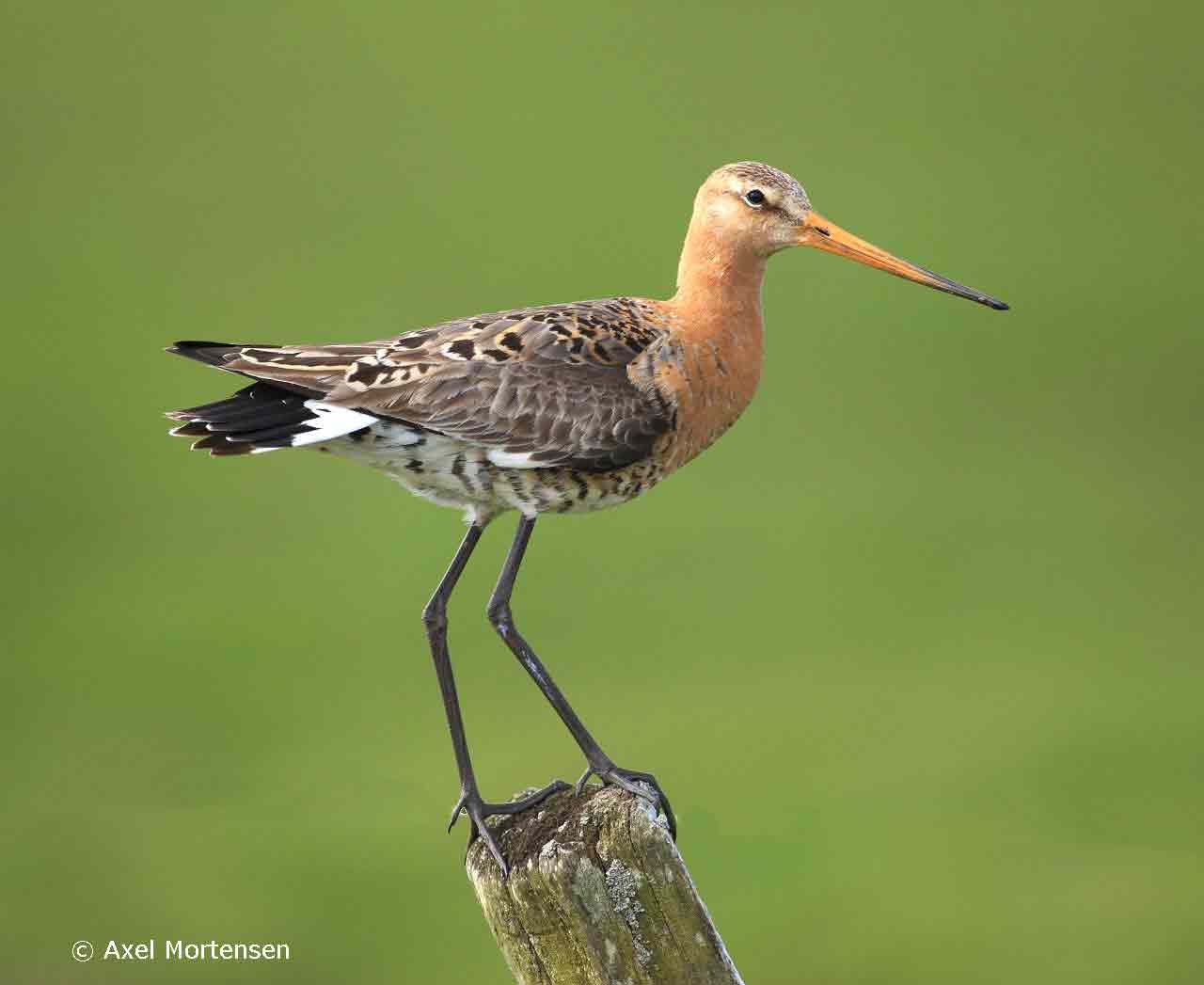
Ålebæk Strand
Møn
Migrating birds in spring – staging seabirds in winter
See Google map with car-park etc.
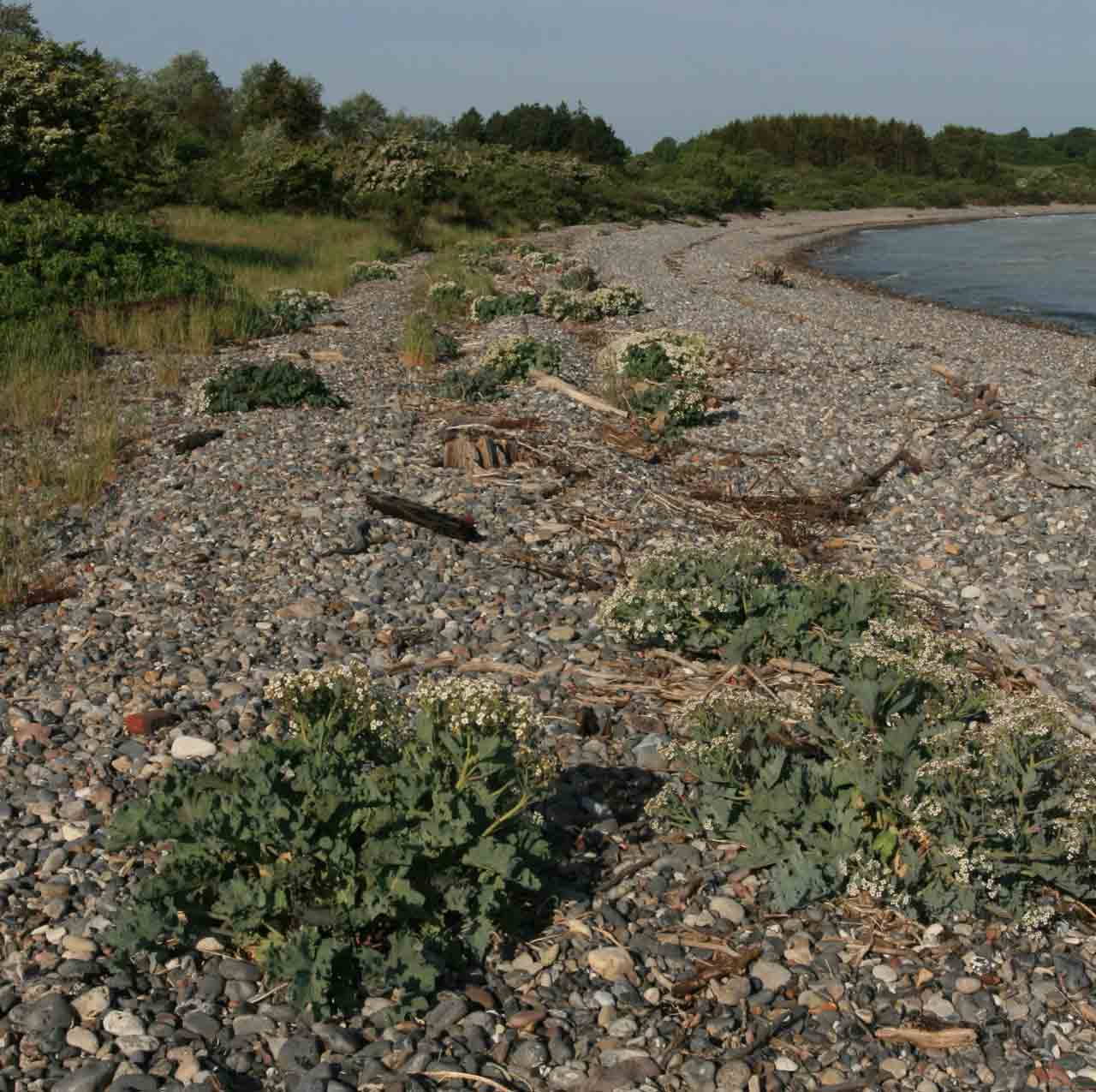
Ålebæk Strand. Photo: Per Schiermacker-Hansen
Description:
The beach of Ålebæk Strand is situated on the north coast of the island of Møn. The coast was formed after an embankment had been built to cut the bog of Borre Sømose off from the sea. The bog was subsequently drained and now consists of farmland. The beach is a pebble beach, and the sea here is quite shallow. On the slope behind the beach and embankment are pine trees and thicket. To the east, in the direction of Møns Klint, are several lovely headlands.
Birds:
Breeding birds:
Many passerines nest in the trees, for example thrush nightingale and icterine warbler, while 1-2 pairs of red-backed shrike can now and then be spotted in the open landscape.
Migrating and staging birds:
Ålebæk Strand is a good viewpoint for watching bird migration in springtime. Most of the migrating birds are passerines, for example skylarks, wagtails, warblers, thrushes, tits, chaffinches and siskins. Many passerines stage in the area and can be seen in the thickets. With luck one may even see firecrest, which appear regularly. Large flocks of corvus species fly out over Ålebæk Strand or along the coast, together with many wood pigeons and stock doves. Barnacle geese have begun to migrate in large numbers over this point. Other migrants include crane, white-tailed eagle, buzzard and red kite.
In winter, the sea off the coast attracts many seabirds. One can spot eider, long-tailed duck, common scoter, velvet scoter, goldeneye and red-breasted merganser. A good many grebes can be seen, especially red-necked grebe. But it is the numbers of slavonian grebe that are exceptional, as they are often seen in double figures, which is very unusual for Denmark. However, they are often quite far out to sea. The slavonian grebes turn up in the middle of October and can be seen until April. Another unusual phenomenon is the occurrence of large concentrations of black-throated divers staging off the coast.
Visiting and access:
In Ny Borre, which is on the 287 road between Stege and Møns Klint, turn to the north-east at the silo and drive along Liselundvej. In Ålebæk, keep to the left and drive north along Ålebæk Strandvej, continuing until the road ends at a car-park. From here, a dirt track leads down to the coast. Just before the slope goes down to the beach, turn left along a path that follows the coastline to the west, from where one can see both the bird migration and the staging birds on the sea.
The area is privately owned, but there is public access to the embankment.
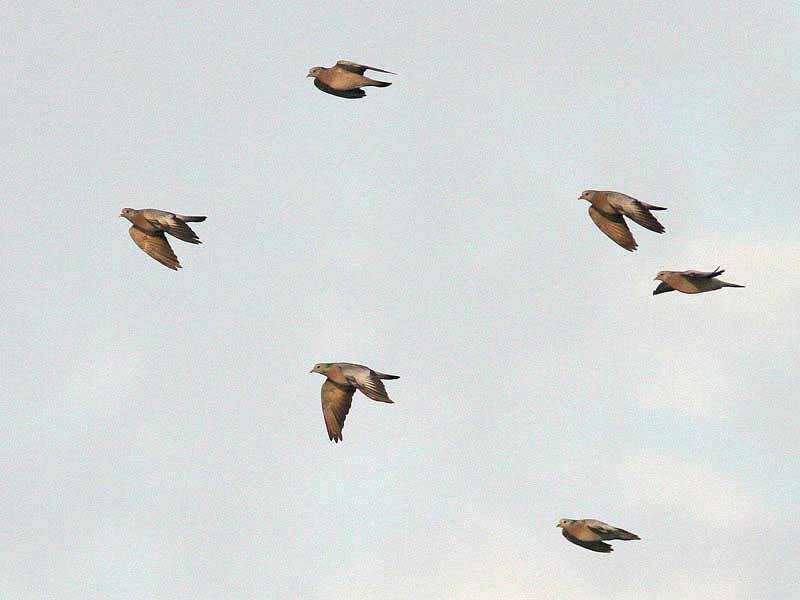
Migrating stock doves. Photo: Klaus Malling Olsen



